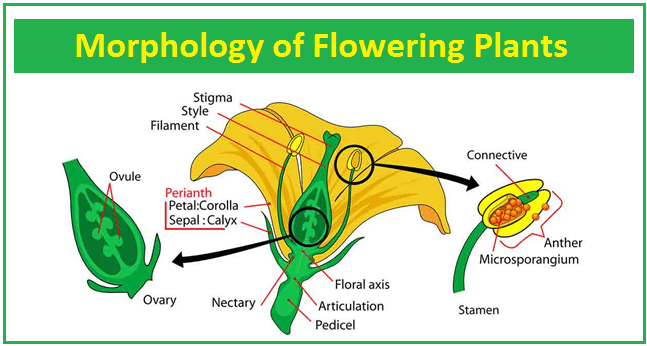Topics
- 1. Introduction
- 2. The root
- 3. Modifications of root
- 4. The stem
- 5. Modifications of stem
- 6. The leaf
- 7. Venation
- 8. Types of leaves
- 9. Phyllotaxy
- 10. Modifications of Leaves
- 11. The inflorescence
- 12. The flower
- 13. Parts of a flower
- 14. Placentation
- 15. The fruit
- 16. The seed
- 17. Semi-technical description of a typical flowering plant
- 18. Description of some important families
Introduction
- The study of external features of an organism is called its morphology.
- All flowering plants or angiosperms consist of root, shoot, leaves, flowers, fruits.
The underground part of the flowering plant is the root system, while the portion above the ground forms the shoot system
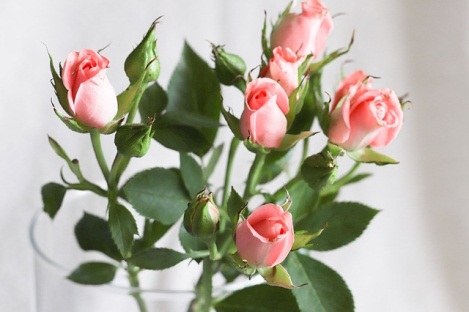
Fig. A flowering plant
The root
- Primary roots are the direct elongation of the radicles.
- Primary roots bear lateral roots of several orders that are referred to as secondary, tertiary roots, etc.
- The primary roots and its branches constitute the tap root system. Example- mustard.
- In monocotyledonous plants, the primary root is short lived and is replaced by a large number of roots originate from the base of the stem and constitute the fibrous root system. Example- wheat plant
- Roots arise from parts of the plant other than the radicle and are called adventitious roots. Example- grass, banyan tree

Fig. Types of roots
Functions of root system
- Absorption of water and minerals from the soil.
- Providing a proper anchorage to the plant parts.
- Storing reserve food material.
- Synthesis of plant growth regulators.
Regions of the root
- The root is covered at the apex by a thimble-like structure called the root cap.
- A few millimeters above the root cap is the region of meristematic activity, which is very small, thin-walled and with dense protoplasm.
- The cells proximal to this region undergo rapid elongation and enlargement and are responsible for the growth of the root in length. This region is called the region of elongation.
- The zone, proximal to region of elongation, is called the region of maturation, where the cells gradually differentiate and mature.
- Some of the epidermal cells from the region of elongation form very fine and delicate, thread-like structures called root hairs, which absorb water and minerals from the soil.
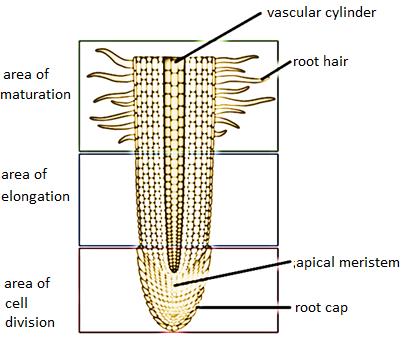
Fig. Regions of root
Modifications of root
- For storage of food- Tap roots of carrot, turnips and adventitious roots of sweet potato, get swollen and store food.

Fig. Turnip
- For mechanical support- prop roots of banyan tree and stilt roots coming out from the stem of maize and sugarcane.
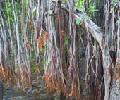
Fig. Prop roots of banyan tree
- For respiration (pneumatophores) -many roots come out of the ground and grow vertically upwards to get oxygen for respiration called pneumatophores. Example-Rhizophora

Fig. Pneumatophores of Rhizophora
The stem
- The stem is the ascending part of the axis bearing branches, leaves, flowers and fruit.
- The stem bears nodes and internodes.
- The regions of the stem where leaves are born are called nodes while internodes are the portions between two nodes.
- The stem bears buds, which may be terminal or axillary.
Functions of stem
- Spreading out branches bearing leaves, flowers and fruits.
- Conducts water, minerals and photosynthates.
- Some stems perform the function of storage of food, support, protection and of vegetative propagation.

Fig. Node and nternode of stem
Modifications of stem
- For storage of food- Underground stems of potato, ginger, turmeric, zaminkand, Colocasia are modified to store food in them.
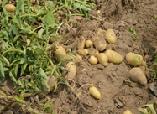
Fig. Underground stem of potato
- For support- Tendrils which develop from axillary buds, are slender and spirally coiled and help plants to climb. Example- gourds

Fig. Pumpkin
- For protection- Axillary buds of stems may also get modified into woody, straight and pointed thorns, which protect plants from browsing animals. Example- Citrus
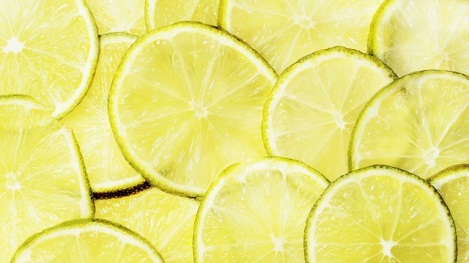
Fig. Citrus fruit
- For photosynthesis- Some plants of arid regions modify their stems into flattened or fleshy cylindrical structures, which contain chlorophyll and carry out photosynthesis. Example-
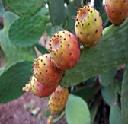
Fig. Opuntia
- For spread and vegetative propagation-
- Underground stems of some plants spread to new niches and when older parts die new plants are formed. Example- grass and strawberry.

Fig. Strawberry plant
- In some plants, a slender lateral branch arises from the base of the main axis and after growing aerially for some time arch downwards to touch the ground. Example- mint and jasmine

Fig. Mint plants
- A lateral branch with short internodes and each node bearing a rosette of leaves and a tuft of roots is found in aquatic plants. Example- Pistiaand

Fig. Pistia
- The lateral branches originate from the basal and underground portion of the main stem, grow horizontally beneath the soil and then come out obliquely upward giving rise to leafy shoots. Example- banana, pineapple.

Fig. Banana plants
The leaf
- The leaf is a lateral, generally flattened structure borne on the stem.
- It develops at the node and bears a bud in its axil called as the axillary bud, which later develops into a branch.
- A typical leaf consists of three main parts: leaf base, petiole and lamina.
- The leaf is attached to the stem by the leaf baseand maybear two lateral small leaves like structures called
- In monocotyledons, the leaf base expands into a sheath covering the stem and in leguminous plants the leafbase may become swollen, which is called the
- The petiole help hold the blade to light.
- The lamina or the leaf blade is the green expanded part of the leaf with veins and veinlets and a middle prominent vein, which is known as the
- Veins provide rigidity to the leaf blade and act as channels of transport for water, minerals.
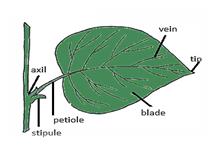
Fig. Parts of a leaf
Venation
- The arrangement of veins and the veinlets in the lamina of leaf is termed as venation.
- When the veinlets form a network, the venation is termed as
- When the veins run parallel to each other within a lamina, the venation is termed as
- Leaves of dicotyledonous plants generally possess reticulate venation, while parallel venation is the characteristic of most monocotyledon.
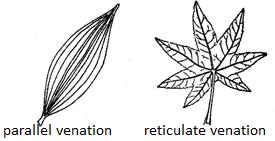
Fig. Parallel and reticulate venations
Types of leaves
- Simple leaves- A leaf is said to be simple, when its lamina is entire or when incised, the incisions do not touch the midrib.
- Compound leaves- When the incisions of the lamina reach up to the midrib breaking it into a number of leaflets, the leaf is called compound.
- The compound leaves may be of two types-
- Pinnately compound leaf
- Palmately compound leaf
- In a pinnately compound leaf a number of leaflets are present on a common axis, the rachis, which represents the midrib of the leaf. Example-neem
- In a palmately compound leaves, the leaflets are attached at a common point, i.e., at the tip of petiole. Example- silk cotton
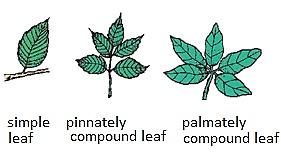
Fig. Types of leaves
Phyllotaxy
- Phyllotaxy is the pattern of arrangement of leaves on the stem or branch.
- Phyllotaxy is of three types
- Alternate
- opposite
- In alternate type of phyllotaxy, a single leaf arises at each node in alternate manner. Example- china rose
- In opposite type, a pair of leaves arise at each node and lie opposite to each other. Example-Calotropis
- In whorled, more than two leaves arise at a node and form a whorl. Example- Alstonia.
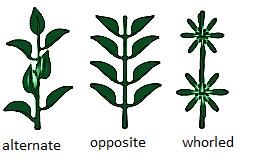
Fig. Types of phyllotaxy
Modifications of Leaves
- Leaf tendrils- They are converted into tendrils for climbing. Example- peas

Fig. Pea plant
- Spines- leaves are modified into spines for defence. Example- cacti

Fig. Cactus
- For storage of food- The fleshy leaves of many plants store food. example- onion and garlic

Fig. garlic leaves
- Phyllode- The petioles in these plants expand, become green and synthesise food. Example- Australian acacia.

Fig. Australian acacia
- Insectivorous plants- Leaves of certain insectivorous plants capture and digest insects are also modified leaves. Example- pitcher plant, venus-fly trap.

Fig. Pitcher plant
The inflorescence
- A flower is a modified shoot wherein the shoot apical meristem changes to floral meristem.
- The arrangement of flowers on thefloral axis is termed as inflorescence.
- Depending on whether the apex gets converted into a flower or continues to grow, two major types of inflorescences are
- racemose
- Cymose
- In racemose type of inflorescence, the main axis continues to grow; the flowers are borne laterally in an acropetal succession.
- In cymose type of inflorescence, the main axis terminates in a flower; the flowers are borne in a basipetal order.

Fig. Types of inflorescence
The flower
- The flower is the reproductive unit in the angiosperms.
- A typical flower has four different kinds of whorls arranged successively on the swollen end of the stalk or pedicel, called thalamusor
- The four different whorls are are calyx, corolla, androecium and gynoecium.
- Calyx and corolla are accessory organs, while androecium and gynoecium are reproductive organs.
- In some flowers, the calyx and corolla are not distinct and are termed as Example- lily.
- When a flower has both androecium and gynoecium, it is
- A flower having either only stamens or only carpels is
- In symmetry, the flower may be actinomorphic(radial symmetry) or zygomorphic(bilateral symmetry).
- When a flower can be divided into two equal radial halves in any radial plane passing through the centre, it is said to be actinomorphic. Example- mustard.
- When it can be divided into two similar halves only in one particular vertical plane, it is zygomorphic. Example- pea.
- A flower is asymmetric(irregular) if it cannot be divided into two similar halves by any vertical plane passing through the centre. Example- canna
- A flower may be trimerous, tetramerous or pentamerous when the floral appendages are in multiple of 3, 4 or 5, respectively.
- Flowers with bracts, reduced leaf found at the base of the pedicel, are called bracteate and those without bracts, are called
- Based on the position of calyx, corolla and androecium in respect of the ovary on thalamus, the flowers are described as
- Hypogynous
- Perigynous
- Epigynous
- In the hypogynous flower, the gynoecium occupies the highest position while the other parts are situated below it, the ovary in such flowers is said to be Example- mustard
- If gynoecium is situated in the centre and other parts of the flower are located on the rim of the thalamus almost at the same level, it is called perigynous, the ovary here is said to be half inferior. Example- plum
- In epigynous flowers, the margin of thalamus grows upward enclosing the ovary completely and getting fused with it, the other parts of flower arise above the ovary. Hence, the ovary is said to be inferior. Example- flowers of guava.
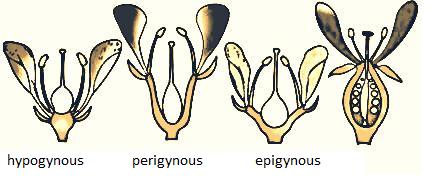
Fig. Hypogynous, perigynous and epignous flowers
Parts of a flower
- Each flower normally has four floral whorls-
- Calyx
- Corolla
- Androecium and
- Calyx-
- The calyx is the outermost whorl of the flower and the members are called
- The calyx may be gamosepalous, when sepals are united or polysepalouswhen sepals are free.
- Corolla
- Corolla is composed of
- Petals are usually brightly coloured to attract insects for pollination.
- If corollas are free, they are called gamopetalousor if united they are called
- Androecium
- Androecium is composed of Each stamen which represents the male reproductive organ consists of a stalk or a filament and an anther. Each anther is usually bilobed and each lobe has two chambers, the pollen-sacs. The pollen grains are produced in pollen-sacs. A sterile stamen is called staminode.
- When stamens are attached to the petals, they are epipetalous. Example- brinjal
- When attached to the perianth, they are called epipellaous. Example- flowers of lily.
- If the stamens in a flower are free, they are called
- When the stamens are united into one bunch or one bundle they are called monoadelphous. Example- china rose
- When the stamens are united in two bundles they are called Example- pea.
- When the stamens are united in more than two bundles, they are called polyadelphous. Example- mustard.
- Gynoecium
- Gynoecium is the female reproductive part of the flower and is made up of one or more
- A carpel consists of three parts namely stigma, style and ovary.
- Ovary is the enlarged basal part, on which lies the elongated tube, the style.
- The style connects the ovary to the stigma.
- The stigma is usually at the tip of the style and is the receptive surface for pollen grains.
- Each ovary bears one or more ovules attached to a flattened, cushion-like placenta.
- When more than one carpel is present, they are free and are called Example- lotus
- When carpels are fused, they are called syncarpous. Example- tomato
- After fertilisation, the ovules develop into seeds and the ovary matures into a fruit.

Fig. A typical flower
Placentation
- The arrangement of ovules within the ovary is known as placentation.
- The placentation is of different types namely, marginal, axile, parietal, basal, central and free central.
- In marginal placentation the placenta forms a ridge along the ventral suture of the ovary and the ovules are borne on this ridge forming two rows. Example- pea
- When the placenta is axial and the ovules are attached to it in a multilocular ovary, the placentaion is said to be axile. Example- china rose.
- In parietal placentation, the ovules develop on the inner wall of the ovary or on peripheral part and ovary become twochambered due to the formation of the false septum. Example- mustard
- In free central, the ovules are borne on central axis and septa are absent. Example- Dianthus
- In basal placentation, the placenta develops at the base of ovary and a single ovule is attached to it. Example – sunflower.
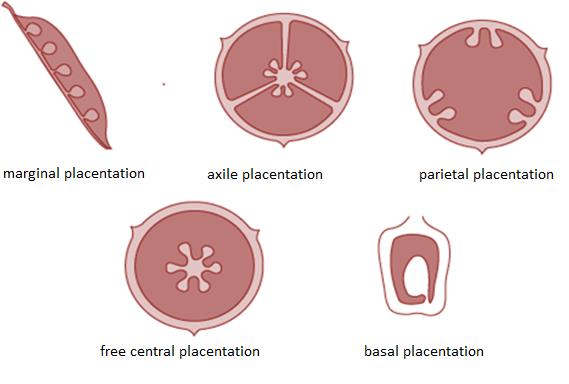
Fig. Types of placentation
The fruit
- The fruit is a characteristic feature of the flowering plants.
- If a fruit is formed without fertilisation of the ovary, it is called a parthenocarpic fruit.
- The fruit consists of a wall or pericarp and seeds.
- When pericarp is thick and fleshy, it is differentiated into the outer epicarp, the middle mesocarp and the inner
- In mango and coconut, the fruit is known as a
- Drupes develop from monocarpellary superior ovaries and are one seeded.
- In some fruits, the pericarp is well differentiated into an outer thin epicarp, a middle fleshy edible mesocarp and an inner stony hard endocarp. Example- mango.
- In coconut, the mesocarp is fibrous.
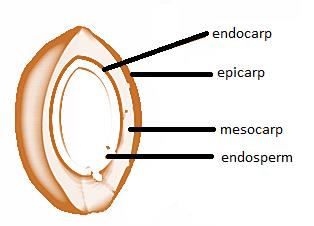
Fig. A fruit
The seed
- The ovules after fertilization, develop into seeds.
- A seed is made up of a seed coat and an embryo.
- The embryo is made up of a radicle, an embryonal axis and one cotyledon or two cotyledons.
Structure of a dicotyledonous seed
- The outermost covering of a seed is the seed coat.
- The seed coat has two layers, the outer testaand the inner
- The hilumis a scar on the seed coat through which the developing seeds were attached to the fruit.
- Above the hilum is a small pore called the
- Within seed coat is the embryo, consisting of an embryonal axis and two cotyledons.
- At the two ends of the embryonal axis are present the radicle and the
- In some seeds, the endosperm formed as a result of double fertilization, is a food storing tissue. Example- castor
- In some plants, the endosperm is not present in mature seeds and such seeds are called nonendospermous. Example- bean
Structure of a monocotyledonous seed
- In some seeds of cereals, like maize, the seed coat is membranous and generally fused with the fruit wall.
- The endosperm is bulky and stores food.
- The outer covering of endosperm separates the embryo by a proteinous layer called aleurone layer.
- The embryo is small and situated in a groove at one end of the endosperm.
- It consists of one large and shield shaped cotyledon known as scutellumand a short axis with a plumuleand a radicle.
- The plumule and radicle are enclosed in sheaths which are called coleoptileand coleorhiza
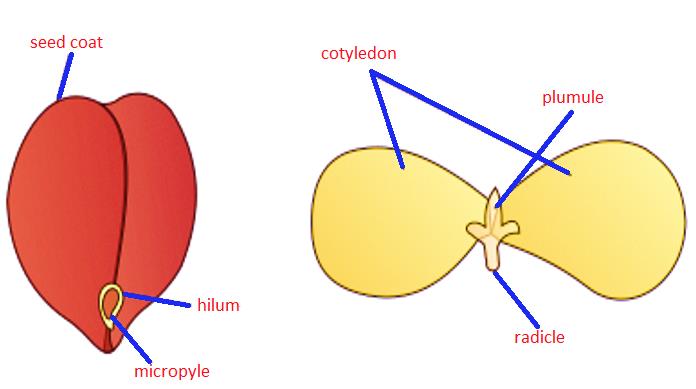
Fig. Structure of a dicot and monocot seed
Semi-technical description of a typical flowering plant
- The plant is described beginning with its habit, vegetative characters such as roots, stem and leaves and then floral characters inflorescence and flower parts.
- After describing various parts of plant, a floral diagram and a floral formula are presented, which is represented by some symbols.
- In the floral formula, Br stands for bracteate K stands for calyx , C for corolla, P for perianth, A for androecium and G for Gynoecium, G for superior ovary and Gfor inferior ovary, for male, for female , ⊕ for actinomorphic and for zygomorphic nature of flower.
- Fusion is indicated by enclosing the figure within bracket and adhesion by a line drawn above the symbols of the floral parts.
- A floral diagram provides information about the number of parts of a flower, their arrangement and the relation they have with one another.
- The position of the mother axis with respect to the flower is represented by a dot on the top of the floral diagram.
- Calyx, corolla, androecium and gynoecium are drawn in successive whorls, calyx being the outermost and the gynoecium being in the centre.
- Floral formula also shows cohesion and adhesion within parts of whorls and in between whorls.
Description of some important families
Fabaceae
- This family was earlier called Papilonoideae, a subfamily of family Leguminosae.
- Vegetative Characters
- Trees, shrubs, herbs
- root with root nodules
- Stem: erect or climber
- Leaves: alternate, pinnately compound or simple; leaf base, pulvinate; stipulate; venation reticulate.
- Floral characters
- Inflorescence racemose
- Flower: bisexual, zygomorphic
- Calyx: sepals five, gamosepalous; imbricate aestivation
- Corolla: petals five, polypetalous, papilionaceous, consisting of a posterior standard, two lateral wings, two anterior ones forming a keel (enclosing stamens and pistil), vexillary aestivation
- Androecium: ten, diadelphous, anther dithecous
- Gynoecium: ovary superior, mono carpellary, unilocular with many ovules, style single
- Fruit: legume; seed: one to many, non-
- Economic importance: Many plants belonging to the family are sources of pulses like gram, arhar; edible oil like soyabean, groundnut; dye like indigofera; fibre like sunhemp; fodder like Sesbania, Trifolium, ornamentals like lupin, sweet pea; medicine like muliathi.

Fig. Family Fabaceae


- It is a large family, commonly called as the ‘potato family’.
- Vegetative characters
- Plants mostly, herbs, shrubs and small trees Stem: herbaceous rarely woody, aerial; erect, cylindrical, branched, solid or hollow, hairy or glabrous, underground stem in potato
- Leaves: alternate, simple, rarely pinnately compound, exstipulate; venation reticulate
- Floral Characters Inflorescence
- Solitary, axillary or cymose as in Solanum
- Flower: bisexual, actinomorphic Calyx: sepals five, united, persistent, valvate aestivation
- Corolla: petals five, united; valvate aestivation
- Androecium: stamens five, epipetalous
- Gynoecium: bicarpellary, syncarpous; ovary superior, bilocular, placenta swollen with many ovules
- Fruits: berry or capsule
- Seeds: many, endospermous
- Economic importance: Many plants belonging to this family are source of food (tomato), spice (chilli); medicine (belladonna); fumigatory (tobacco); ornamentals (petunia).
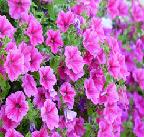
Fig. Solanaceae family
Floral formula and floral diagram

Liliaceae
- Commonly called the ‘Lily family’ is a characteristic representative of monocotyledonous plants.
- Vegetative characters:
- Perennial herbs with underground bulbs/corms/ rhizomes
- Leaves mostly basal, alternate, linear, exstipulate with parallel venation
- Floral characters
- Inflorescence: solitary / cymose; often umbellate clusters
- Flower: bisexual; actinomorphic
- Perianth tepal six (3+3), often united into tube; valvate aestivation
- Androcium: stamen six, (3+3)
- Gynoecium: tricarpellary, syncarpous, ovary superior, trilocular with many ovules; axile placentation
- Fruit: capsule, rarely berry
- Seed: endospermous
- Economic Importance: Many plants belonging to this family are good ornamentals (tulip), source of medicine (Aloe), vegetables (Asparagus), and colchicine (Colchicum autumnale).

Fig. Liliaceae
- Commonly called the ‘Lily family’ is a characteristic representative of monocotyledonous plants.
- Vegetative characters:
- Perennial herbs with underground bulbs/corms/ rhizomes
- Leaves mostly basal, alternate, linear, exstipulate with parallel venation
- Floral characters
- Inflorescence: solitary / cymose; often umbellate clusters
- Flower: bisexual; actinomorphic
- Perianth tepal six (3+3), often united into tube; valvate aestivation
- Androcium: stamen six, (3+3)
- Gynoecium: tricarpellary, syncarpous, ovary superior, trilocular with many ovules; axile placentation
- Fruit: capsule, rarely berry
- Seed: endospermous
- Economic Importance: Many plants belonging to this family are good ornamentals (tulip), source of medicine (Aloe), vegetables (Asparagus), and colchicine (Colchicum autumnale).

Fig. Liliaceae



